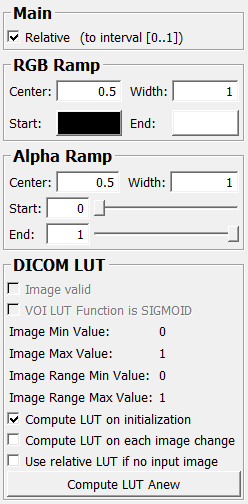RampLUT¶
-
MLModule¶ genre LUTauthor MeVis Medical Solutions AGpackage MeVisLab/Standarddll MLLUTToolsdefinition MLLUTTools.def see also LUTPrimitive,LinearLUT,TableLUT,ChangeLUTColor,LUTInfo,LUTCurve,ApplyLUT,SoMLLUT,Windowkeywords lookup,table,center,width,level,window
Purpose¶
The module RampLUT generates an RGB and alpha ramp lookup table (LUT) object.
The LUT can be used with the ApplyLUT module or within 2D/3D viewers (in conjunction with SoMLLUT). The two ramps for RGB and alpha channels can be parametrized independently.
Usage¶
Select parameters for the RGB Ramp and the Alpha Ramp. For both ramps, specify Center and Width, as well as Start and End color or alpha value.
Connect the outLUT output field to a SoMLLUT module to use the LUT in a 2D/3D viewer, or to an ApplyLUT module to apply the LUT to an ML image.
The module also has an ML image input; if a valid ML image is connected, the module RampLUT can set a default LUT based on the image’s min/max value or, if existing, on the LUT set in the DICOM tags.
Details¶
See LUT Functions for general information about ML lookup tables.
For the exact handling of the DICOM Window Center and Window Width tags see the Details section of DicomLUT.
Parameter Fields¶
Field Index¶
Center (center): Double |
Image Min Value: Double |
useCorrectDicomLinearLutInterpretation: Bool |
Center (alphaCenter): Double |
Image Range Max Value: Double |
VOI LUT Function is SIGMOID: Bool |
Compute LUT Anew: Trigger |
Image Range Min Value: Double |
Width (width): Double |
Compute LUT on each image change: Bool |
Image valid: Bool |
Width (alphaWidth): Double |
Compute LUT on initialization: Bool |
Relative: Bool |
|
End (endColor): Color |
Start (startColor): Color |
|
End (alphaEnd): Double |
Start (alphaStart): Double |
|
Image Max Value: Double |
Use relative LUT if no input image: Bool |
Visible Fields¶
Relative¶
-
name:relative, type:Bool, default:TRUE¶ If checked, the generated LUT is relative, i.e. the index value interval [0..1] is rescaled to the true image value range before applying the LUT. If the LUT is absolute, on the other hand, the image values are used as index values directly, without rescaling.
Center (center)¶
-
name:center, type:Double, default:0.5¶ Sets the center index value of the ramp, either as an absolute image value or relative to [0..1].
Width (width)¶
-
name:width, type:Double, default:1¶ Sets the width value of the ramp, either as an absolute image value range or relative to [0..1].
Start (startColor)¶
-
name:startColor, type:Color, default:0 0 0¶ Sets the color used for index values below the start of the ramp (i.e. index <= center-width/2).
End (endColor)¶
-
name:endColor, type:Color, default:1 1 1¶ Sets the color used for index values above the end of the ramp (i.e. index >= center+width/2).
Center (alphaCenter)¶
-
name:alphaCenter, type:Double, default:0.5¶ Sets the center index value of the ramp, either as an absolute image value or relative to [0..1].
Width (alphaWidth)¶
-
name:alphaWidth, type:Double, default:1¶ Sets the width value of the ramp, either as an absolute image value range or relative to [0..1].
Start (alphaStart)¶
-
name:alphaStart, type:Double, default:0, minimum:0, maximum:1¶ Sets the alpha value used for index values below the start of the ramp (i.e. index <= center-width/2).
End (alphaEnd)¶
-
name:alphaEnd, type:Double, default:1, minimum:0, maximum:1¶ Sets the alpha value used for index values above the end of the ramp (i.e. index >= center+width/2).
Image valid¶
-
name:isImageValid, type:Bool, persistent:no¶ Shows whether the attached image is valid (or if there is an image attached).
VOI LUT Function is SIGMOID¶
-
name:isSigmoidVOILUT, type:Bool, persistent:no¶ Indicates if the VOI LUT Function tag of the input image is set to SIGMOID. Nonetheless the module will always create a linear ramp LUT.
Use relative LUT if no input image¶
-
name:useRelativeIfNoInputImage, type:Bool, default:FALSE¶ If checked, the module uses a relative LUT in [0..1] if no input image is attached.
If there was an input image attached and the module used an absolute LUT and the image is detached while this flag is checked, the module uses the same LUT as before just in relative bounds.
Compute LUT on initialization¶
-
name:shouldComputeLUTOnInitialization, type:Bool, default:TRUE¶ If checked, the module computes the LUT automatically based on the input image on initialization, i.e., after a saved network has been loaded. Otherwise, the stored LUT values (center, width) are just used.
Compute LUT on each image change¶
-
name:shouldComputeLUTOnEachImageChange, type:Bool, default:FALSE¶ If checked, the module computes a default LUT on each update of the input image.
Compute LUT Anew¶
-
name:computeLUTAnew, type:Trigger¶ If pressed, the LUT is computed anew on base of the input image’s DICOM tags.
The DICOM tags used to compute the LUT are: WindowCenter, WindowWidth, SlopeIntercept, and SlopeRescale.
Image Min Value¶
-
name:imageMinValue, type:Double, persistent:no¶ Shows the input image’s minimum value (or 0 if no image is attached).
Image Max Value¶
-
name:imageMaxValue, type:Double, persistent:no¶ Shows the input image’s maximum value (or 1 if no image is attached).
